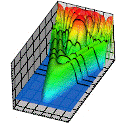Department of Physics and Astronomy: Publications and Other Research

Anthony F. Starace Publications
Document Type
Article
Date of this Version
2018
Citation
PHYSICAL REVIEW A 98, 063433 (2018)
DOI: 10.1103/PhysRevA.98.063433
Abstract
Using the analytic time-dependent effective range theory, we study two-color high-order harmonic generation (HHG) involving a weak extreme ultraviolet (XUV) pulse and an intense infrared laser field. Our analysis shows that XUV-assisted HHG spectra contain multiple additional plateau structures originating from absorption of one or more XUV photons at the photorecombination step of HHG. We show also that the HHG rate corresponding to the nth plateau can be presented in a factorized form involving the XUV-assisted (multiphoton) photorecombination cross section (PRCS) corresponding to absorption of n XUV photons of energy Ω and emission of a harmonic of energy Ωh. This factorization allows one to extract the PRCS from the HHG spectrum and to retrieve the cross section of the inverse process: the photoionization cross section involving absorption of a single photon of energy Ωh and emission of n XUV photons of frequency Ω. The analytic HHG results are in excellent agreement with numerical solutions of the three-dimensional time-dependent Schrödinger equation.
Included in
Atomic, Molecular and Optical Physics Commons, Elementary Particles and Fields and String Theory Commons, Plasma and Beam Physics Commons


Comments
©2018 American Physical Society